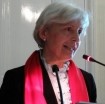Ilona Sármány-Parsons
ILONA SÁRMÁNY-PARSONS is a Hungarian art historian based in Vienna. After earning her PhD from the Budapest University (ELTE), she worked at the Institute of Art History at the Hungarian Academy for ten years before leaving for Austria. She has taught at the University of Debrecen, the University of Vienna and University of Nottingham. In 2000 she was a fellow at the Getty Research Institute in Los Angeles and from 1991 until 2015 she was Permanent Visiting Professor at the Central European University in Budapest. Her special field is the art and architecture of the Austro-Hungarian Empire during the reign of Emperor Franz Joseph. She has contributed studies on architecture, painting and the applied arts in Hungarian, German and English to numerous exhibition catalogues and study volumes. Her book on Gustav Klimt (1987) was published in English, German, French, Czech, Russian and Japanese, and Viennese Painting at the Turn of the Century (1991, 2nd ed. 2003) also appeared in Hungarian, English and German. Over the past few years she has published studies on the Hungarian painters Károly Ferenczy (2011) and István Csók (2013), and on Egon Schiele (2013). In 2015, she edited and wrote the introductory study for a volume on the art critic of the Vienna Secession (Ludwig Hevesi und seine Zeit, Wien). She was the curator of the exhibition entitled The First Golden Age held from November 2016 to March 2017.

